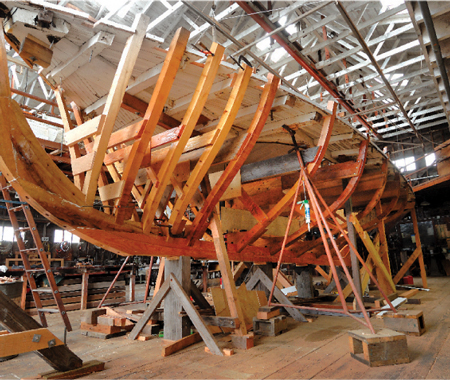Change comes slowly along the Sausalito waterfront. Take Myron Spaulding’s namesake boatworks, for example. In the 56 years since the legendary sailboat designer and builder and concert violinist founded the yard at the foot of Gate Five Road, nothing much has been altered but the name. After Spaulding died in 2000, the business became the Spaulding Wooden Boat Center. Other than that, it’s pretty much the same as it was in Spaulding’s day.
Sunlight still streams in through skylights in the 50-foot-high ceiling. The same tools, patterns and presses and even some of the same lumber pieces line the redwood-paneled walls. The black and orange stiff-leg derrick Spaulding operated for 50 years (originally it was used to build a dam in North Dakota) still enables the yard to repair craft weighing up to 12 tons. Old documents hang from the walls. One, a frayed and faded 44-year-old Fair Labor Standards Act poster, makes sure everyone realizes “the minimum wage is now $1.25 an hour.”
Indeed, the Spaulding Wooden Boat Center oozes so much history that San Francisco Chronicle reporter Carl Nolte once dubbed it “a cathedral of wooden boats.” More prosaically, the voluminous center might be described as a clinic for wooden boats. The best-known (and biggest) current “patient” under the watchful eye of students from the Arques School of Traditional Boatbuilding (which recently relocated to the center) is the Freda, a craft widely considered to be the oldest active sailing yacht on San Francisco Bay.
“Some refer to Freda as ‘the common man’s yacht,’” says Mark Welther, the center’s executive director. “Others say she’s the ‘matriarch of San Francisco Bay.’” Whatever it is called, the Freda, a 32-foot gaff sloop built in Belvedere in 1885 for a commodore of the Corinthian Yacht Club, is in for a bottom-to-top overhaul that will take two more years to complete. “By the time this full keel-off restoration of Freda is finished,” says Welther, “we’ll have $250,000 in it and hundreds if not thousands of professional and volunteer work-hours.”
Boatyard general manager Michael Wiener, 60, still lives in the Sausalito home where he was born. “However, I did spend four years of wooden boatbuilding apprenticeship at Waldsted in Denmark,” he adds. In 1978, with his apprenticeship complete, Wiener stopped by New York’s famed Sparkman & Stephens yacht design firm to find out where he might best apply his newly acquired woodworking skills. “Without knowing where I was from,” Wiener says, “they urged I get in touch with Spaulding Boatworks in Sausalito—which was my hometown.” He’s been working there ever since.
Wiener agreed to manage the yard following Spaulding’s death. In 2004, after the death of Spaulding’s widow, Gladys, the Spaulding Wooden Boat Center became a nonprofit trust dedicated to “preserving the working boatyard, restoring classic wooden sailboats, and educating the public about the boatbuilding tradition,” Welther adds.
The boatyard’s paying customers help sustain the center’s existence. “We have a crew of five,” Wiener says, “and that’s fine for now.” The center services fiberglass as well as wooden sailboats. “Our niche is quality of work, attention to detail and always trying to do the best possible job,” he adds. “We’re probably the longest continually functioning remnant of the old Sausalito waterfront.”


